|
This issue: Contents
Tuesday, August 26th, 2014
Editor’s Note Oh Minnesota. Sunday and Monday it’s so hot and humid I couldn’t make it to my car without breaking a sweat. And today, I regret not packing a sweatshirt. I suppose our schizophrenic weather can be explained by taking a glance at the calendar. How did we get to the end of August already?! Fall is coming folks! In our News Section, take a minute and check out a few upcoming events we have planned for this autumn that we’d love to see you at! Now, the one nice thing about reaching the end of August is that we are currently right in the middle of State Fair season! So before you head off to the Great Minnesota Get-Together, scroll down to see a photograph of an exhibit the State Prison once displayed at the Fair, read what was hyping up the 1911 Fair crowds, and learn a bit about the history of our own Washington County Fair in the Featured Article. Want to learn more about the history of Washington County? Become a fan of WCHS on Facebook or follow us on Twitter! See a new photo every week, read special articles, and stay up-to-date with the latest WCHS happenings. Sean Pallas Historical Messenger editor and Warden’s House Site Manager
WCHS News “Earliest Residents of the Valley” PresentationThe Washington County Historical Society will host Ken Martens on Sunday, September 7th at 2:00 PM for a free and open to the public presentation on the Native American settlement, history and legends of the St. Croix River Valley. This often-overlooked element of our local history will be highlighted by Mr. Martens, Vice President of the Afton Historical Society and author of “The Perilous St. Croix River Valley Frontier”. This event will be free and open to the public. From burial mounds to warring chieftains, this exciting presentation will cover centuries of drama and human intrigue that flowed down the coastline of the powerful St. Croix River. The Warden’s House Museum is located at 602 Main Street N., Stillwater, MN. Please contact Sean Pallas at spallas.wchs@gmail.com or 651-439-5956 with any questions regarding this event or to schedule a tour of the museum. WCHS News Fall Membership Dinner MeetingOn Thursday, September 25th WCHS will be holding it’s annual Fall Membership Meeting at the Water Street Inn, Stillwater. The guest speaker for the meeting will be Frederick Johnson, author of “The Sea Wing Disaster”. On July 13th, 1890, the steam-driven, paddlewheel-powered Sea Wing slipped beneath the stormy waters of Lake Pepin along with 98 of her passengers. She then quickly sunk into the depths of historical obscurity. Mr. Johnson will raise the memory of this Minnesotan tragedy back to the surface in this gripping maritime tale. The meeting will start with a social hour at 5:30 pm, dinner is served at 6:30 pm, with the meeting and presentation to follow at 7:30 pm. Tickets to the dinner/presentation are $20 for WCHS members and $25 for non-members. Reservations are required. 651-439-5956. Photo of the Week
State Prison at the State Fair – c. 1930 After the new Minnesota State Prison in South Stillwater (Bayport) was completed in 1914, it would refer to itself as the best prison in the nation for the next several decades. And like any good Minnesotan institution with a healthy amount of pride, the prison would make an annual pilgrimage to the State Fair. In fact, the State Fair was actually considered the prison’s busy-season. And that wasn’t because roudy Fair goers would be sent to cool-off at the big-house; the prison was seen as one of the attractions! To accomodate the influx of curious visitors the prison administration actually printed out annual Hand Books “to furnish in brief and succinct form a clear and comprehensive conception of the institution and the way and manner in which it is conducted.” The booklet’s introduction stated that, “Very often during State Fair week as many as a thousand visitors are shown through the various departments in a single day”. And undoubtedly, many of their guests’ main points of interest were the state-of-the-art manufacturing plants. The four-system twine factory at the prison could have been plucked from the dreams of Henry Ford. Utilizing four complete sets of matching machinery (hence, the “four-system factory”) the 500 inmates working in the twine plant in 1929 produced 24 million pounds of twine. For a bit of comparison, from 1853 to 1903, the prison plant only generated around 5 million pounds of twine. Once processed, the finished twine was wrapped into 8 lb bundles. The photograph above shows a mock prison cell at the State Fair constructed almost completely out of these twine bundles. Old News State Fair AdvertisementInstead of typing out today’s Old News, I’ll let you take a look at this advertisement as it appeared in the Stillwater Messenger on August 26th, 1911.
Although today the main attraction of the Fair is, “Come! Eat way too much food…It’s on a stick!” you can see they were going for a more sophisticated approach a century ago. Promising “No Fakes or Freaks” and styled as “The Mecca for All Believers in Progress” the Fair of 1911 was billed foremost as an educational experience.In the first decade of the 20th century, the Minnesota State Fair prided itself in showcasing modern advances for the home and farm. For example, a prototype mechanized cow milking machine was first exhibited at the 1908 State Fair. Of course, they enjoyed slightly flashier technological advancements as well. The very first mechanical flight in Minnesota had been demonstrated a year prior at the 1910 fair, and the famous Wright Brothers were once again on the itinerary. Another exciting element of the 1911 Fair mentioned in the ad was the exhibition of the famous racing horse, Dan Patch. In 1911, Dan Patch was a 15 year old, undefeated, 9 world-record holding harness-racing horse on his way to retirement. This wouldn’t be the first time the famous steed had visited the fair. In fact, the Grandstand you can see today was constructed in 1909 due the enormous crowds Dan drew to the Fair. But his 1911 State Fair appearance is special because this was the final public exhibition of this animal athlete’s long and successful career. Dan Patch’s fame and accomplishments lead Hollywood to create several movies about his life and a number of early automobile companies to adopt his name. But perhaps the most prestigious honor is that when entering the Minnesota State Fair main gate from Snelling, guests will find themselves walking down Dan Patch Avenue. Now that you’re armed with a bit of trivia about the State Fair, head to the Fairgrounds this week and keep in mind the more than hundred year long history the modern fair is built upon – and then don’t forget to pick up a bucket of Martha’s Cookies before you leave…
FEATURED ARTICLE Getting Together Since 1871by Brent Peterson Every year at the beginning of this month, a certain fragrance in the air starts around Lake Elmo and glides to every corner of Washington County. The smell of Pronto Pups and Cheese Curds and the sound of “Bingo” being yelled by young children and older adults, put these together and it can only mean the start of the Washington County Fair. The first fair was held in Cottage Grove in the fall of 1871. The next year the fair was held in Stillwater at the old Parson Farm, at the corner of Orleans Street and Sixth Avenue. At this fair, the Stillwater Fire department brought out their new equipment to show, there was a squash from Afton that weighed 140 pounds and a quilt made by a seven year old girl. The following year the fair was moved to the Lily Lake Driving Park in Stillwater. After some disagreement about the percentage of the gate to be given to the driving park, the fair moved to Bass Lake [Lake Elmo] in 1875. In 1876 at Bass Lake, baseball was the game and there were matches everyday with the St. Croix Club of Stillwater, Clippers of Winona, Red Caps of St. Paul, Blue Stocking of Minneapolis, Silver Stars of Northfield, Crescents of Hastings. There was a $100 prize for the champion of the fair. The next year, 1877, a tornado hit the fairgrounds in Bass Lake, and the fairs of 1877, 1878, and 1879 were held again at the Lily Lake Driving Park. For the next couple of decades it is unclear where the fair was held or even if there was a fair held at all. In October 1903 the Washington County Fair Association was organized. In 1907, the fair opened in Forest Lake on West Broadway near the railroad tracks for the first couple of years. The fair then moved to an open field between NW Second Street and NW Third Street until around 1917 or 1918 when the World War put an end to the fair for a while. In the early 1920s, Bayport was given the chance to have the county fair. It opened in 1924 at Crocus Park at the south end of the town. In 1927 the fair had record crowds turn out at Crocus Park. In 1928 the Capitol Amusement Company were engaged to run the carnival on the grounds. There was also Kittenball game, dances and an industrial exhibit of automobiles, washing machines and electric refrigerators. In 1933, more than 8,000 people attended, a record for Crocus Park. The attendance record again had broken in 1936, and more than 10,000 visitors came to the fair at Crocus Park in 1945. Also in 1945, the fair board purchased the former Veterans Conservation Corps [VCC] site in Bayport and the fair moved there starting in 1946. The fair was held in Bayport through the 1969 fair, and the new Washington County Fair Grounds were completed and the first fair held in Lake Elmo was in August 1970. The fair grounds have grown and more buildings have been added since 1970 and this year’s fair in early August was a stunning success; drawing thousands of Washington County’s citizens together and continuing this 19th century tradition. |
|
Month: August 2014
|
This issue: Contents
Tuesday, August 12th, 2014
Editor’s Note Before I launch into this week’s issue of the Historical Messenger I’d like to announce that the WCHS Annual Fall Meeting will be held on Thursday, September 25th this year. Our guest speaker is author Frederick Johnson who will give a presentation on the Sea Wing disaster. Keep your eyes on the e-newsletter, social media pages, and local news outlets for information on how to reserve your tickets. Speaking of events, here’s a huge ‘thank you’ to everyone who made it to Hay Lake Day on Saturday! Here’s a few pictures of the day’s events for those who missed the fun. 1 2 3 4 In our News section today you’ll find two more scheduled presentations from our busy summer schedule. And I suppose the rest of this issue of the Historical Messenger has the unintentional theme of saying goodbyes. In our Photo of the Week you’ll read some final reflections from our interns as their time with us comes to an end. We’ll read the obituary of one of Washington County’s earliest settlers in Old News. And finally we’ll end this issue with a selection from intern Anna Peterson’s research project on the history of the Stillwater Area High School Band. Want to learn more about the history of Washington County? Become a fan of WCHS on Facebook or follow us on Twitter! See a new photo every week, read special articles, and stay up-to-date with the latest WCHS happenings. Sean Pallas Historical Messenger editor and Warden’s House Site Manager
WCHS News The Warden at the Warden’s HouseJoin the current head of the Stillwater Minnesota Correctional Facility, Warden Michelle Smith this Wednesday, August 13th at 7 PM at the Warden’s House Museum. This year marks the 100th anniversary of the Stillwater prison moving from downtown Stillwater to it’s current location just south of the city. In commemoration, Warden Michelle Smith will visit the historic Warden’s House Museum to give a free and open to the public presentation. Warden Smith will dive into the day-to-day operations and challenges she encounters while leading a 100-year old facility with roughly 1,600 male inmates. She also will detail her personal career path; from corrections officer to warden of the Stillwater Prison and discuss some of the improvements and goals of her tenure as warden. The Warden’s House Museum is located at 602 Main Street N., Stillwater, MN. Please contact Sean Pallas at spallas.wchs@gmail.com or 651-439-5956 with any questions regarding this event or to schedule a tour of the museum. WCHS News Hay Lake Speaker Series: Vintage Base BallThe Way It Was Meant To Be PlayedMatt Carter, Executive Director of the Dunn County Historical Society and team captain for the Menomonie Blue Caps, will present “Vintage Base Ball: The Way it Was Meant to be Played on Sunday, August 24 at the Hay Lake Museum and Erickson Log House Museum in Scandia, Minnesota. The event begins at 2:00 PM and is FREE to the public. Carter will present the similarities and differences between modern baseball and the vintage game. “We’ll talk about what vintage base ball is, the rules we play by and the customs that have been developed for entertainment purposes,” Carter said. The Dunn County Historical Society sponsors the Menomonie Blue Caps vintage base ball team, located in Menomonie, Wisconsin. The Blue Caps are the only team in Western Wisconsin and play most of their matches throughout the year against Eastern Minnesota teams, including WCHS’ St. Croix Base Ball Club. For further information contact Hay Lake Museum Manager Dustyn Dubuque at 651-433-4014 or dustyn.dubuque@hotmail.com. Photo of the Week
Good-Bye Interns! We had a sad ‘so-long!’ to our pair of summer interns this past weekend. After setting up a few hundred books for the Hay Lake Day sale, Hay Lake Manager Dustyn Dubuque (left) and myself (right) snagged a quick selfie with our parting interns Emily Batroot (left) and Anna Peterson (right). We wish them both the best of luck and extend our sincere gratitude for all the help they’ve given us over the last 10-weeks! Here’s what Anna and Emily had to say about their internship experiences: ” The past ten weeks of this internship have flown by! It has been such a great opportunity and privilege to be able to work with the Washington County Historical Society. I have had the chance to see how a museum functions from the inside. I’ve also gained social skills by giving tours and educating people about the history that has come from our county. The internship gave me the liberty to dive into a topic that I’ve always wanted to know more about, the Stillwater Area High School band program. With the valuable resources here at the historical society I was able to piece together the beginnings of the band and dig up some information that otherwise could have been lost. Along with doing research and giving tours at the Warden’s House museum I was able to make connections with people that could last a lifetime!” – Anna Peterson “From dusting, to the Beer Tasting to the county fair and more, there was never a dull moment during my internship at the Washington County historical Society. I learned a lot throughout my ten week internship, I learned not only how to become a better public speaker and tour guide for visitors, but I also learned a lot about the day to day operations of a historical society and its museums. I also had the chance to create a display on toys and games in the Hay Lake School museum. This project helped me to learn more about historical research and exhibit design, not to mention learning about Whirligigs and Kick the Can. I greatly appreciated the opportunity to work with the Washington County Historical Society because I feel that I have gained so many transferrable skills that I could bring into any career path I choose.” – Emily Batroot Old News
A Frontierswoman Passes On
This article honors the first European woman to settle in the St. Croix River Valley – Lydia Carli. Her half-brother, Joseph R. Brown, had convinced her to move out to the Minnesotan frontier in 1841. Here she would remain for the next 64 years and in that time, Lydia Carli would have witnessed not only the founding of Stillwater, but it’s growth into a major industrial center. “Death of Mrs. Lydia Ann Carli” – Stillwater Messenger – August 12, 1905 The relatives and friends of Mrs. Lydia Carli were startled Friday morning to hear that she had quietly passed away Thursday night. Mrs. Carli is one of the oldest pioneer residents of this valley. She was born March 13, 1818, near Lancaster, PA. Her father was Rev. Samuel Brown, a Methodist minister of some note. An uncle, John Hart, on the maternal side was one of the signers of the Declaration of Independence. She married Paul J. Carli in Chicago, in 1824 who was drowned at Afton, in this county, in 1845. In 1846 she married Dr. Carli, her husband’s brother. Mrs. Carli was the first white woman to set her foot on the shores of Lake St. Croix at Stillwater. Mrs. Carli has had a most eventful life and in all the ups and downs that has marked her intercourse with her relatives, friends and neighbors she has always borne a cheerful and happy disposition. By her first husband she bore five children – Maria, Joseph, John, Lucetta and Rose. Rose and John died young. By Dr. Carli she had seven children – all dying before their 23rd year but C. H. Carli, who still survives. FEATURED ARTICLE Bastien’s Band
If you mention the last name of ‘Bastien’ to a jazz or classical musician in the Twin Cities, you may get a response referring to the bassist ‘Biddy’, or cellist and arranger ‘Vin’. You may hear about the Gene Krupa Band or the studio band at WCCO and you may even hear about piano lessons. There were many Bastien’s all siblings and all accomplishedmusicians; Vince, Annette, Gertrude, Biddy, Tony, Dave and Billy. For example, Biddy is 1 of 27 in the Twin Cities Jazz Hall of Fame. But where they came from, and who inspired the music within was their father, the second band director at Stillwater High School, William H. Bastien. At a young age William Bastien knew he wanted to perform, he told his father, at the age of 11, that he wanted to be a concert violinist. His family didn’t agree and kicked him out of the house to live in a barn. From then on William started making money as a violinist in his town. A few years down the road he met a very talented prodigy pianist named Estelle. Her mother had died in childbirth and she had been passed down from relative to relative. They fell in love and decided it would be cheaper if they were to live together. They got married around 1910; William was 16 and Estelle 13 years old. They later moved to Pine City, Minnesota where they would live until 1920, when William was offered a position in Buel, Minnesota as a bandmaster. The family stayed in Buel until 1930, when the money ran out for the bandmaster position. William moved his family once again to Minneapolis where he started school for a teaching certificate at Minneapolis College of Music (now McPhail School of Music). Once obtaining the degree he obtained a position teaching at Stillwater High School in 1933. By 1936 the band had their largest enrollment ever. There were 36 members and were working their way to 45 by the end of the year. That same year, the band tied for 3rd place with Anoka High School at their district contest Bastien was the only director at the high school to direct both the orchestra and the band. And it was under the direction of him, and the newly founded choir by Miss Fairchild in 1938 that the music department was able to have its first annual department wide concert on April 5th, which included the band, orchestra and choir. A report of the concert from the Stillwater Arrow on April 26th, 1938 says this: “A packed auditorium listened to selections by the band and orchestra… and by the choir. Several outstanding selections included on the varied program presented by the band and orchestra were: “The Big Bass Drum”; the clarinet trio composed of Jerry Davis, Helen Andrewson, and Frank Phalen; the French horn solo by Billy Bastien; and “Every Little Movement” played by the orchestra.” Bastien later had to abandon the orchestra because of lack of interest in students wanting to learn stringed instruments. Bastien himself was responsible for all of the private instrumental lessons each student would get each week at school. On average he would be giving sixty or seventy individual lessons each week, on various instruments. By 1938 and 1939 the band had grown significantly. There were about 40 in the band, and 20 playing in the orchestra. With the creation of a concert choir in 1937, Stillwater’s music department had become quite large. Because of the growing numbers the band was constantly fundraising for new uniforms for the incoming students and replacing of the used uniforms.
Under the direction of Mr. Bastien, the band had improved significantly. In 1947 the band received their first ‘A’ rating at a district contest. They continued to the state regional contest to earn a ‘B’ rating. According to the ‘Kabekonian’, “when Mr. Bastien first began directing the band in 1933, of the thirty students to sign up for band, only three students could read music…. In the past two years the band has received an “A” and a “B” rating in the district contest and a “B” rating in the regional contest. This year the band also shows great promise for the 1949 contest.” Unfortunately in January of 1949, Bastien’s son Patrick, who had just begun studies at the University of Minnesota, unexpectedly committed suicide. This left Director Bastien, his wife and family beside themselves and prompted the leave of Bastien from the Stillwater Schools. This leave was of shock to the students and provoked articles of gratitude on his leave in the Stillwater Arrow, and in the Gazette. “There must be first of all an innate musicianship in the director himself. Then he must be able to transmit that quality to the players in the organization. He must keep the group under control at all times and yet retain the admiration and respect of the members of his group. From my observation, Mr. Bastien certainly qualifies in all these characteristics. To you Mr. Bastien, may you enjoy many more years in the fields of work, which is, I know, close to your heart. We are going to miss you. Sincerely, Margaret L. Clark” |
|




 The dawn of the 20th century was a period of transition for Stillwater and Washington County as a whole. The lumber industry had begun its slow decline, new technologies such as the automobile were reaching the valley, and the first generation of settlers were passing away.
The dawn of the 20th century was a period of transition for Stillwater and Washington County as a whole. The lumber industry had begun its slow decline, new technologies such as the automobile were reaching the valley, and the first generation of settlers were passing away. by Anna Peterson
by Anna Peterson